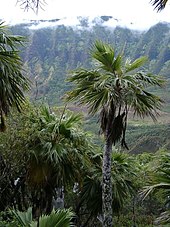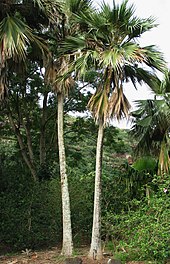Pritchardia
| Pritchardia | ||||||||||||
|---|---|---|---|---|---|---|---|---|---|---|---|---|

Pritchardia sp. |
||||||||||||
| Systematics | ||||||||||||
|
||||||||||||
| Scientific name | ||||||||||||
| Pritchardia | ||||||||||||
| Seem. & H. Wendl. ex H. Wendl. |
Pritchardia is a palm genus native to the islands of the Western Pacific. These fan palms have their main distribution centeron the Hawaiian Islands.
features
The representatives are moderately large, solitary, unreinforced fan palms . They are hermaphroditic and bloom several times. The trunk is erect, sometimes deeply furrowed, and covered with closely spaced leaf scars.
The number of chromosomes is 2n = 36, 36 ± 2.
leaves
The leaves are folded induplicat and costapalmat . In young, stemless individuals they remain on the plant after they die (marzescence), in older plants they fall off under their own weight. The leaf sheath is hairy and soon disintegrates into fibers. The petiole is long, flat or with a groove on the upper side, the underside is rounded or angular. The stem goes over into the costa (middle rib) without transition. The hastula of the upper side of the leaf is an edge with a central point, the hastula of the lower side is missing.
The leaf blade is divided into one-third to one-half of the radius along the adaxial folds into simply folded segments. They are only slightly incised along the abaxial folds. Filaments between the folds are often present. The segments are rigid and stand in one plane, or they hang differently. The surfaces are similar, or the undersides are clearly glaucous . Often they are clearly hairy on the ribs, and small scales are also common.
Inflorescences
The inflorescences stand individually between the leaves (interfoliar), or in twos or threes in a leaf axil. They are then enveloped by the common cover sheet . An inflorescence triple branched. The peduncle is conspicuous, stiff, upright to pendulous, shorter or longer than the leaves. The cover sheet is tubular, two-keeled, close-fitting, densely hairy and sometimes disintegrates into fibers. There are several bracts on the stem, these are similar to the cover sheet, tend to tear open along one side, are sometimes inflated. Adaxially they are glabrous, abaxially densely hairy, rarely later balding. The inflorescence axis is significantly shorter than the stem. The flower-bearing axes (rachillae) are straight, curved or slightly zigzag-like. They are often crowded, forming a head of flowers. The rachillae are bald or slightly to densely hairy and have small bracts in a spiral arrangement, each of which has a single flower.
blossoms
The flowers are hermaphroditic. They are sitting or standing on low tubercles. Bracteols are not recognizable. The calyx is tubular, flat, three-lobed, rather thick and leathery. The crown protrudes clearly above the calyx, is leathery, tubular at the base, and divided above into three elongated, valvate tips. The lobes form a cap that slopes down towards the anthesis . The six stamens are close to the tube throat, the filament bases are fused and form a conspicuous tube that protrudes over the calyx. The latrorsen anthers sit on the short free tips . The gynoeceum consists of three wedge-shaped carpels. In the lower area they are free in the region of the common, long stylus they are fused. The scar is small and three-lobed. The ovule is basal and anatropic. The pollen is ellipsoidal and has a slight to clear asymmetry, sometimes the pollen is flattened triangular. The germ opening is a distal sulcus.
Fruits and seeds
The fruits are spherical to ovoid and develop from just one carpel. They bear the remnants of scars apically and the remains of the undeveloped carpels. The chalice is persistent. The exocarp is smooth, the mesocarp is rather thin, fleshy, and fibrous, the endocarp is thin, woody and rather brittle. The seed is spherical, starts basal or subbasal, has a rounded umbilicus (hilum). The endosperm is homogeneous. The seed coat is slightly thickened in the hilum, but does not reach into the endosperm.

distribution
Pritchardia occurs in Fiji , Tonga , the Danger Islands and the Hawaiian Islands. All but five species are endemic to Hawaii . Many species are very rare and endangered, some have been lost for years.
Most of the Hawaiian species grow on the windward slopes of the islands in the humid forests from sea level to 1600 m above sea level. Few representatives occur in the dry forests on the leeward sides.
Systematics
The genus Pritchardia Seem. & H. Wendl. is placed within the family Arecaceae in the subfamily Coryphoideae , tribe Trachycarpeae . However, it cannot be assigned to any subtribe within the tribe. The genus is likely monophyletic . Pritchardia may be the sister group of Washingtonia .
The Royal Botanic Gardens, Kew's World Checklist of Selected Plant Families recognizes the following species:
- Pritchardia arecina Becc. : It isendemic toeastern Maui .
- Pritchardia bakeri Hodel : She is endemic to Oahu .
- Pritchardia beccariana Rock : It is endemic to the Mauna Loa in Hawaii.
- Pritchardia flynnii Lorence & Gemmill : It is endemic to Kauai .
- Pritchardia forbesiana Rock : It occurs only in eastern Molokai and western Maui .
- Pritchardia glabrata Becc. & Rock : Only found on Lanai and western Maui .
- Pritchardia gordonii Hodel : It occurs only on Kohala in Hawaii.
- Pritchardia hardyi Rock : It only occurs on Kauai .
- Pritchardia hillebrandii Becc. : It only occurs in northern Molokai .
- Pritchardia kaalae Rock : It occurs only in western Oahu .
- Pritchardia kahukuensis Caum : It is endemic to the Ko'olau Mountains on Oahu .
- Pritchardia lanigera Becc. : She is endemic to Hawaii.
- Pritchardia lowreyana Rock ex Becc. : It occurs only on Oahu and in eastern Molokai .
- Pritchardia maideniana Becc. : She is endemic to Hawaii.
- Pritchardia martii (Gaudich.) H. Wendl. : She is endemic to Oahu .
- Pritchardia minor Becc. : She is endemic to Kauai .
- Pritchardia mitiaroana J. Transf . & Y. Ehrh. : Endemic to Mitiaro from the Cook Islands and Makatea and Niau from Tuamotu .
- Pritchardia munroi Rock : Endemic to Molokai and Maui .
- Pritchardia napaliensis H.St.John : It is endemic to Kauai .
- Pritchardia pacifica Seem. & H. Wendl. : The home is Vavau from the Tonga Islands .
- Pritchardia perlmanii Gemmill : Endemic to Kauai .
- Pritchardia remota (Kuntze) Becc. : She is endemic to Nihoa and Niihau of the Hawaiian Islands.
- Pritchardia schattaueri Hodel : She is endemic to Hawaii.
- Pritchardia tahuatana Butaud & Hodel : The species first described in 2017 occurs on the Marquesas islands of Tahuata and Fatuiva .
- Pritchardia thurstonii F. Muell. & Drude : It is endemic to eastern Fiji and Tonga .
- Pritchardia viscosa Rock : It is endemic to Kauai .
- Pritchardia vuylstekeana H. Wendl . : It only occurs on Tuamotu .
- Pritchardia waialealeana Read : It is endemic to Kauai .
- Pritchardia woodii Hodel : It is endemic to eastern Maui .
Pritchardia was first described by Hermann Wendland in 1862 , the type species is Pritchardia pacifica Seem. & H. Wendl. ex H. Wendl. The generic name honors William Thomas Pritchard (1829-1907), a British consul in Fiji.
Synonyms of the genus are Eupritchardia Kuntze and Styloma O.F. Cook .
literature
- John Dransfield, Natalie W. Uhl, Conny B. Asmussen, William J. Baker, Madeline M. Harley, Carl E. Lewis: Genera Palmarum. The Evolution and Classification of Palms . Second edition, Royal Botanic Gardens, Kew 2008, ISBN 978-1-84246-182-2 , pp. 283-285.
Individual evidence
- ↑ a b Rafaël Govaerts (Ed.): Pritchardia. In: World Checklist of Selected Plant Families (WCSP) - The Board of Trustees of the Royal Botanic Gardens, Kew . Retrieved August 3, 2018.
- ↑ Lotte Burkhardt: Directory of eponymous plant names . Extended Edition. Botanic Garden and Botanical Museum Berlin, Free University Berlin Berlin 2018. [1]




